Zuger Kirschtorte (Swiss Cherry Torte from Zug) is the cake you never knew you needed in your life. It's composed of layers of sweet almond meringue, soft sponge cake soaked in kirsch syrup, and is finished with glossy coral pink kirsch buttercream and crunchy sliced almonds.
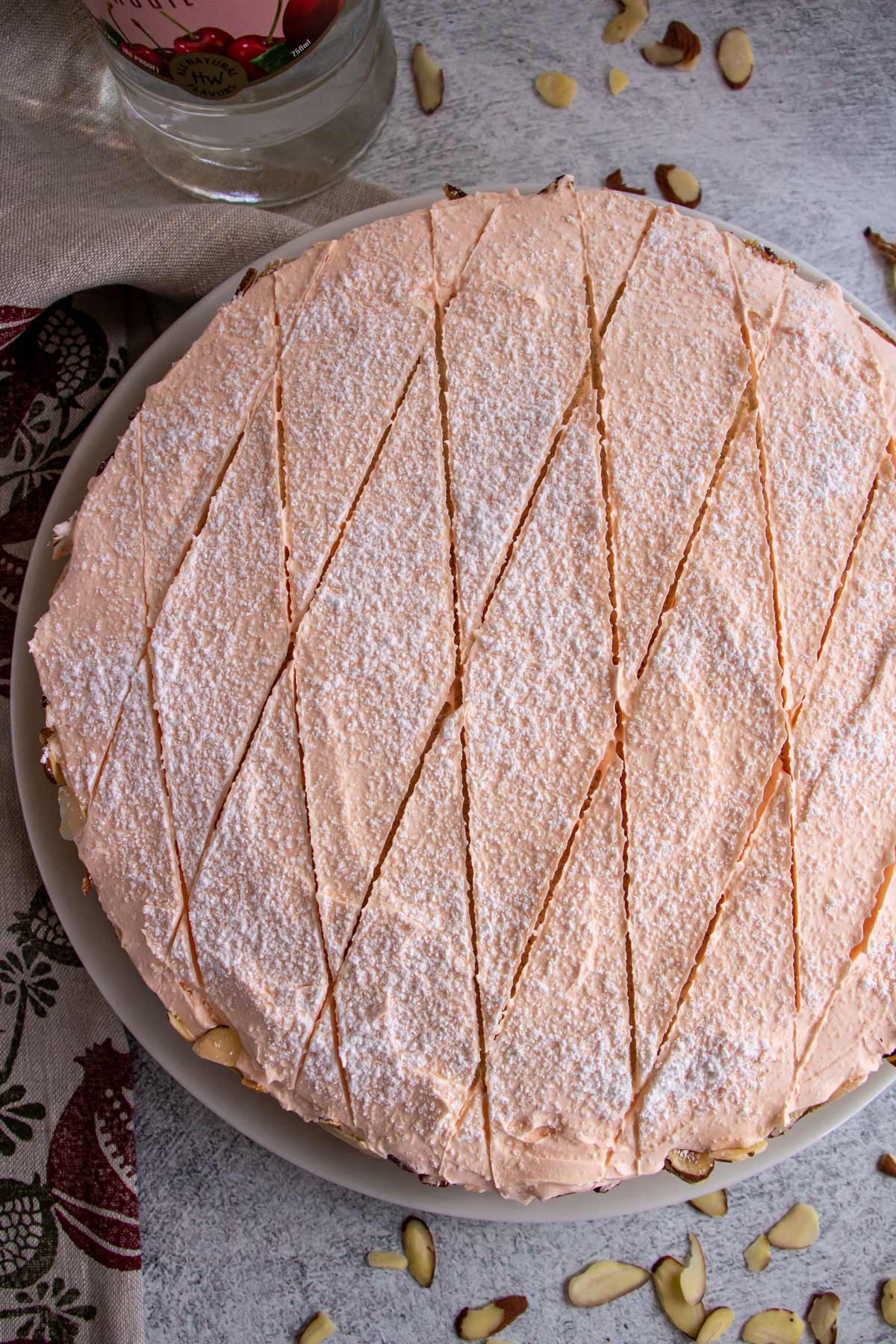
There are many gorgeous European cakes worthy of any celebration. One in particular that I believe deserves a place on that list is the boozy cherry-infused Zuger Kirschtorte. Pastry chef Heinrich Höhn invented the cake in 1921 in the Swiss city of Zug (approximately halfway between Zurich and Lucerne) at a café called Konditorei Treichler.
This showstopper cake won gold medals in pastry exhibitions in Lucerne in 1923 and 1928 and in London in 1930. It was so popular that even Charlie Chaplin and Audrey Hepburn were fans. If that's not enough to convince you to try this cake, let me assure you that after trying this cake for myself, it immediately became one of my personal favorites as well.
It may seem daunting, as it requires four separate components, but this Zuger Kirschtorte recipe is very straightforward. I have shared as many details and tips as I could to help make it foolproof. Be patient, use the right tools (a digital scale, electric mixer, instant read thermometer, and candy/deep fry thermometer are a good start), and enjoy!
One of the best parts of this cake is that the garnishes of sliced almonds around the sides and confectioners' sugar on top will help cover up any mishaps. I'm not an expert cake decorator by any means, and I think my Zuger Kirschtorte turned out beautiful. It tasted even better!
Flavor-wise, you can definitely taste the kirsch both infused into the cake and in the icing. If you have a strong aversion to alcohol or want a more family-friendly cake, you might want to sit this one out. Aside from the boozy factor, the cake is super soft and tender and the French buttercream is absolutely decadent with just the right amount of sweetness.
Ingredient notes

- Almond Meal: For this Zuger Kirschtorte you'll need ground almonds, almond meal, or almond flour. You can easily grind your own almonds in a food processor or purchase almond meal at many grocery stores and online. I like to get my almond meal at Trader Joe’s, although Aldi, Whole Foods, and Bob’s Red Mill brands also are great choices. Store leftover almond flour in a tightly sealed freezer bag in the freezer for longevity.
- Eggs: This recipe uses egg whites for the Japonoise, whole eggs for the genoise, and egg yolks for the French buttercream. You’ll need the egg whites for the Japonaise before you need the egg yolks for the French buttercream, so I recommend separating the yolks into a bowl, covering with plastic wrap, and refrigerating until you are ready to use them. Then weigh them and add more yolks if needed.
- Kirschwasser: Kirschwasser is a clear, colorless cherry brandy. If you have trouble finding Kirschwasser (Kirsch for short) ask your local liquor store if they will do a special order for you, since not every liquor store may carry it. You can also make your own Kirsch from cherry brandy essence (20 ml). Pour the contents of the bottle along with 280 grams of granulated sugar into an empty one liter bottle. Add 770 ml of neutral vodka. Then shake vigorously until the sugar has completely dissolved.
- Sliced Almonds: As you toast the sliced almonds, some of the skins may loosen. If they fall off the almonds, pick through and discard any pieces of almond skin before using the toasted sliced almonds to decorate the cake.
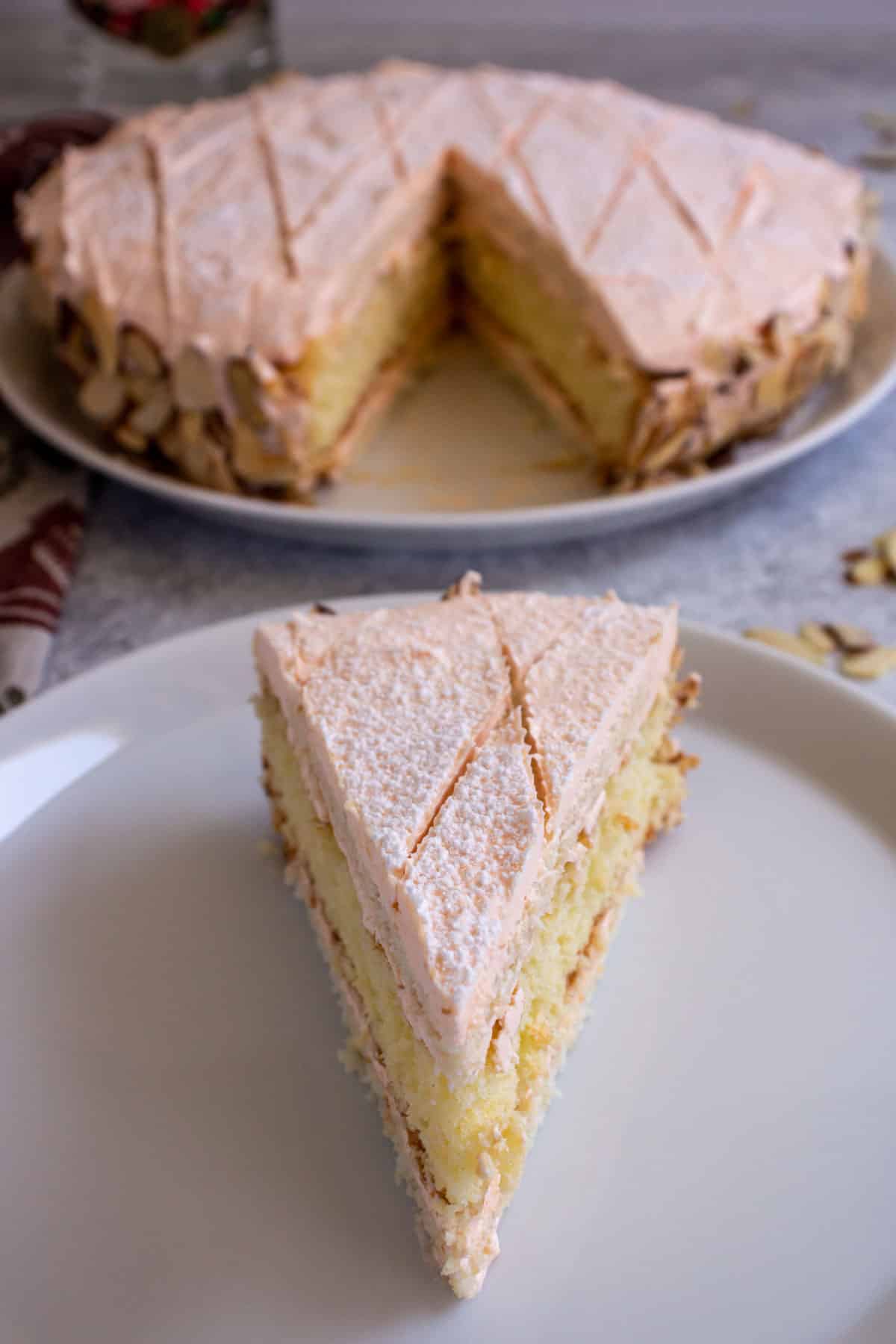
How to make it
Although this Zuger Kirschtorte recipe seems long and complicated, it’s surprisingly not. Make sure you read through the steps before starting, prepare your pans and set out your ingredients ahead of time. A lot of the same ingredients are repeated through the different components so keep them within reach.
Japonaise Meringue
Preheat the oven to 350°F (177°C) with the racks in the upper and lower thirds. Draw 9-inch circles on 2 sheets of parchment paper and lay them upside down on 2 baking sheets (you should be able to see the circle drawing through the paper).
Whisk together the almond meal and cornstarch in a mixing bowl and set aside.
In the bowl of an electric mixer fitted with the whisk attachment, beat the egg whites to medium peaks. With the mixer running, slowly pour in the sugar. Continue beating until the mixture is smooth and shiny, and you have stiff peaks.
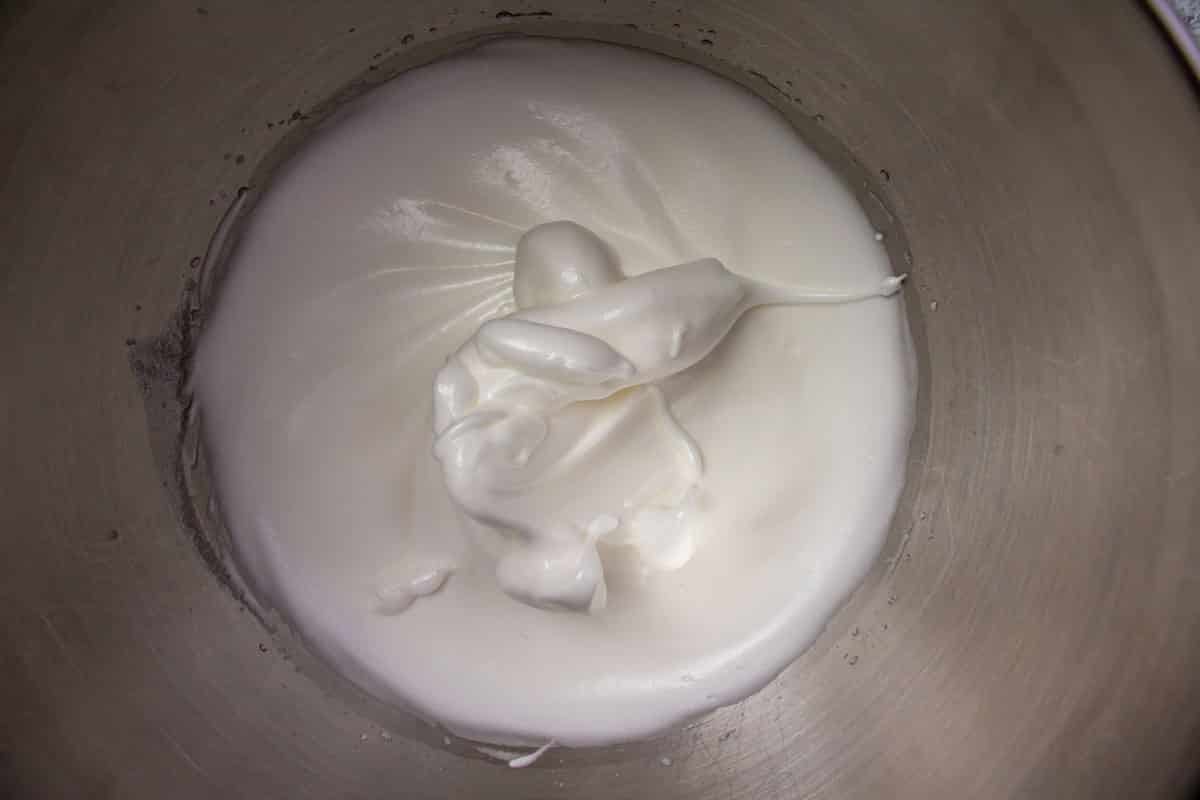
Carefully fold in half the almond mixture using a rubber spatula (PHOTO 1), then fold in the remaining half (PHOTO 2). Doing a little at a time helps mix it evenly without deflating the meringue.

Either spread or pipe the mixture in concentric circles (starting in the centers and moving outward) inside the drawn circles, leaving about ½-inch clearance from the edges in case it expands.
Bake meringues for about 10 to 15 minutes, rotating pans partway through, or until they are dry. Set aside to cool.
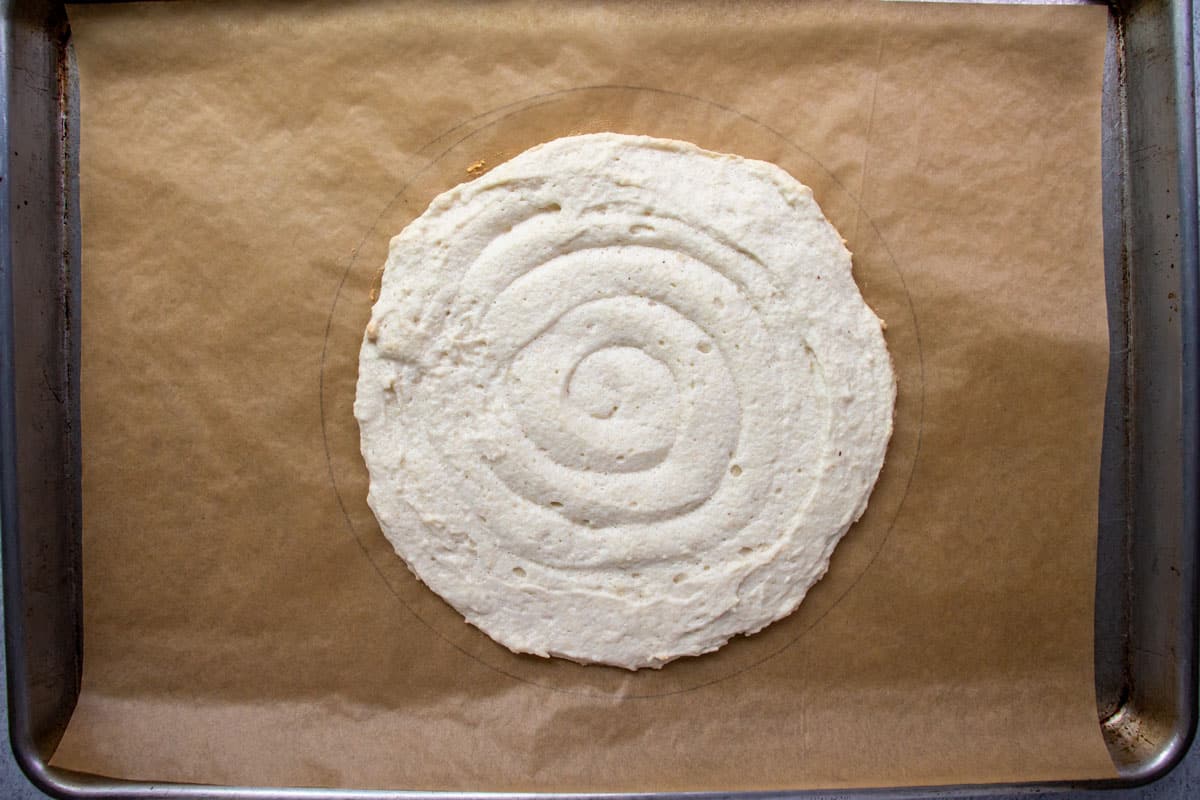
Genoise Sponge
Preheat the oven to 350°F (177°C) with the rack in the center. Butter a 9-inch round cake pan or 9-inch springform pan and line the bottom with parchment paper.
Fill about an inch of water in a saucepan and bring it to a boil, then reduce the heat to simmer.
Combine the eggs and sugar together in the bowl of an electric mixer.

Whisk together by hand, then place the bowl over the simmering water (make sure the bowl doesn’t touch the water) and continue whisking by hand until the mixture is about 115°F (46°C) (use an instant read thermometer).
Remove the bowl from over the water and place on the mixer stand. Using the whisk attachment on the stand mixer, beat until it has more than tripled in volume and is pale in color. The outside of the mixer bowl will feel cool to the touch.
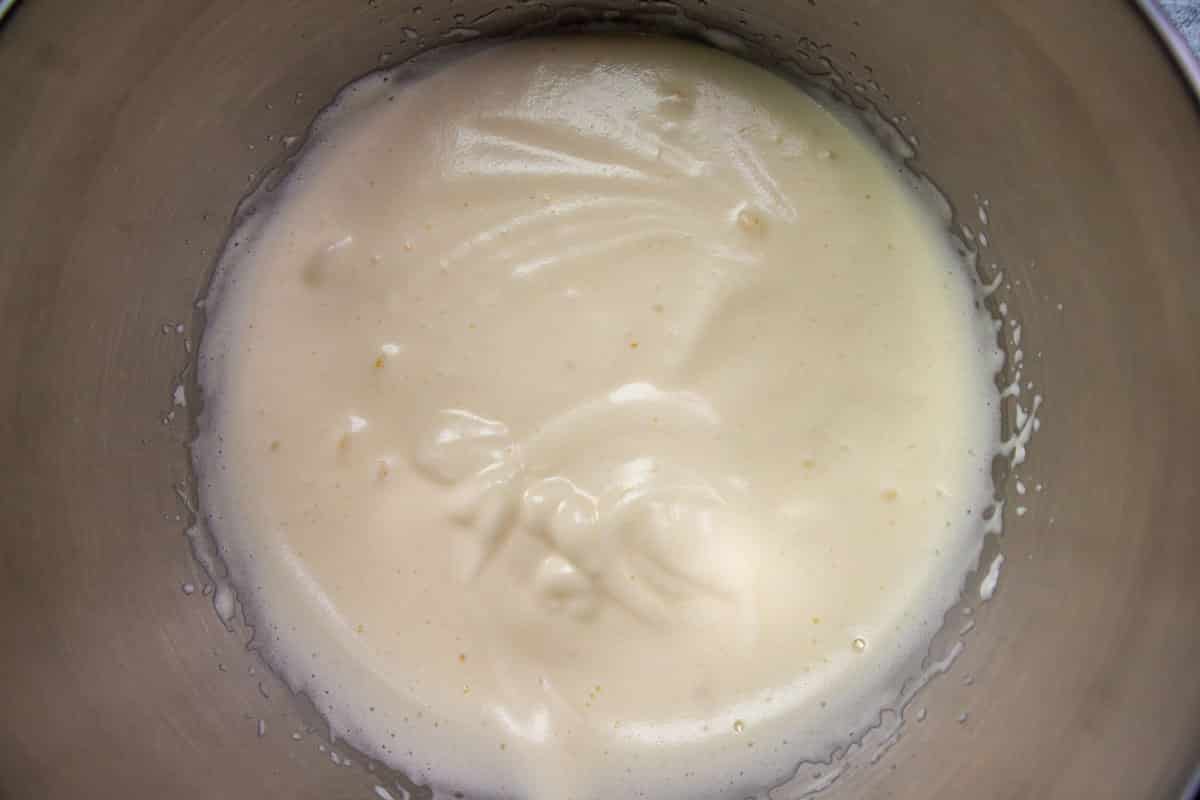
Combine the flour and cornstarch in a small bowl, then sift the mixture over the eggs and gently fold it in using a rubber spatula (PHOTOS 3-4).

Scrape the batter into the prepared pan, smooth the top (PHOTO 5), and bake for about 22 to 25 minutes, or until the top is golden and springs back when lightly touched (PHOTO 6).
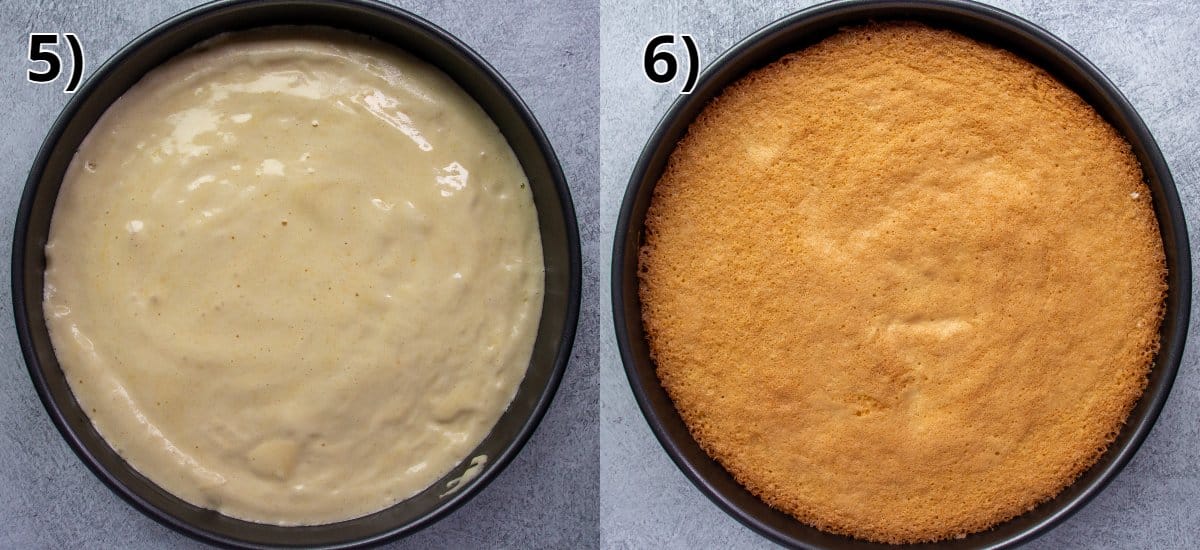
Cool in the pan on a wire rack for 10 minutes. Loosen the sides with a spatula if necessary, then unmold the cake from the pan onto a wire rack to cool completely.

Kirsch Syrup
In a small saucepan, combine the water and sugar over medium-high heat. Bring to a simmer, stirring to dissolve the sugar, and then remove from the heat. Cool the syrup completely, then stir in the kirsch. Set aside until ready to use.
Kirsch French Buttercream
Combine the sugar and water in a saucepan. Bring to a boil over medium-high heat, gently swirling to dissolve the sugar. Continue to boil the mixture without stirring until it reaches a temperature of 240°F (115°C) using a candy/deep fry thermometer.
Meanwhile, beat the yolks in a stand mixer fitted with the whisk attachment until they are thick and pale.
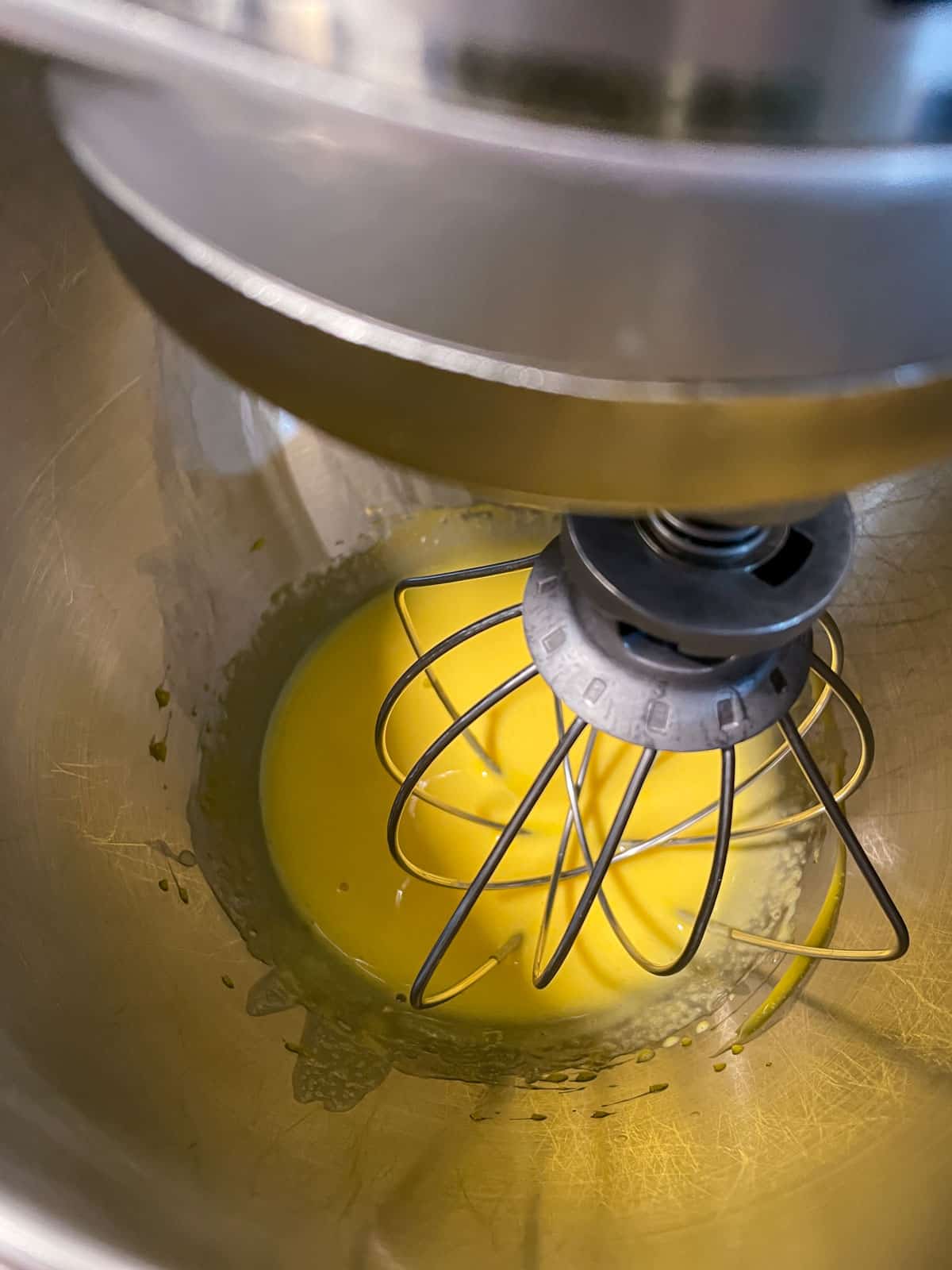
Once the syrup reaches 240°F (115°C), immediately remove it from the heat. With the mixer still running, pour the syrup very slowly into the beaten yolks (between the whisk and the side of the bowl).
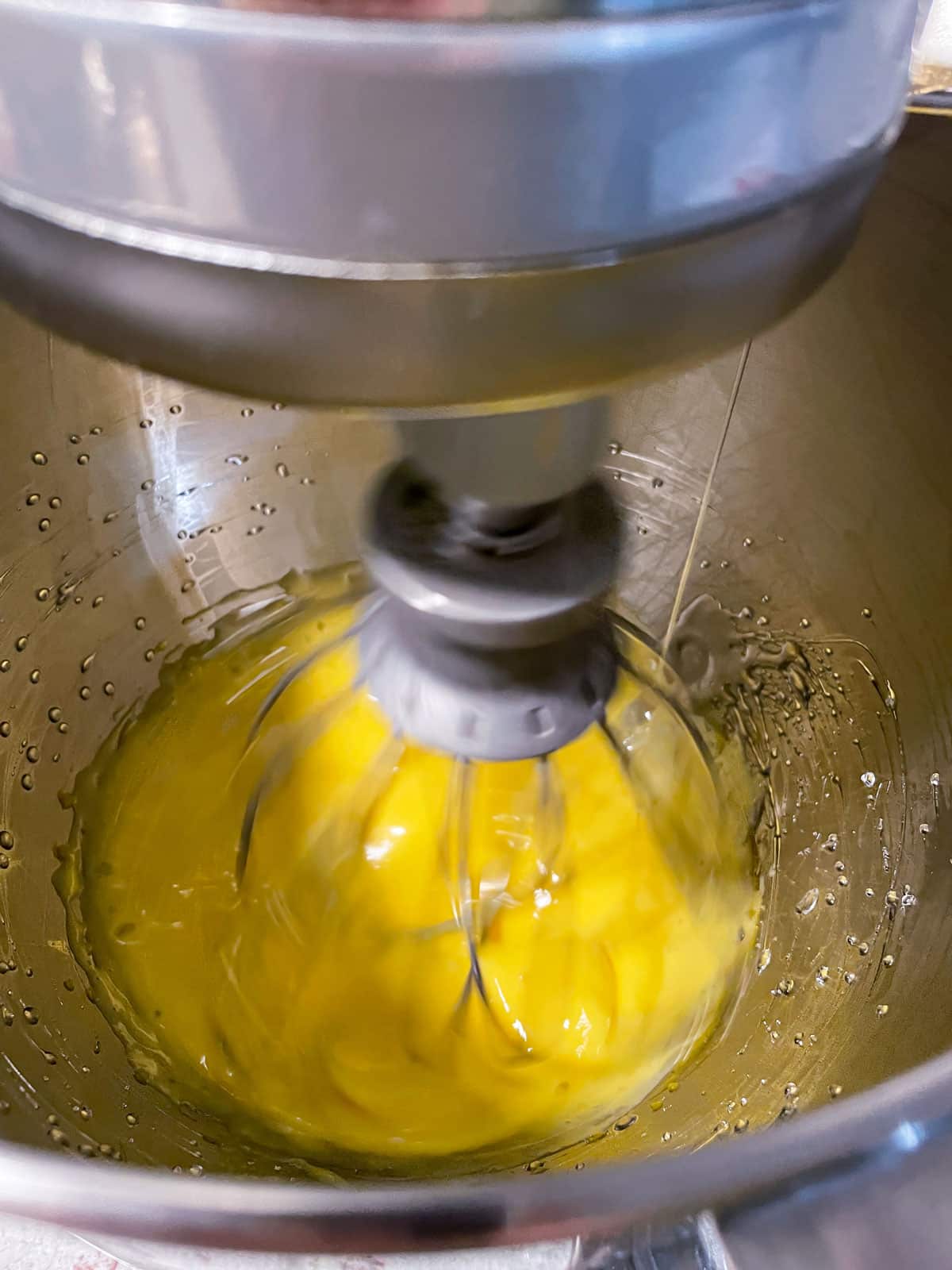
Continue beating the mixture until it’s completely cool, about 10 to 15 minutes. It will get thick and will be pale creamy white in color.

Whip in the room temperature butter on low speed a little at a time. Once the butter is fully incorporated, increase the speed to high and beat for another 3 minutes.
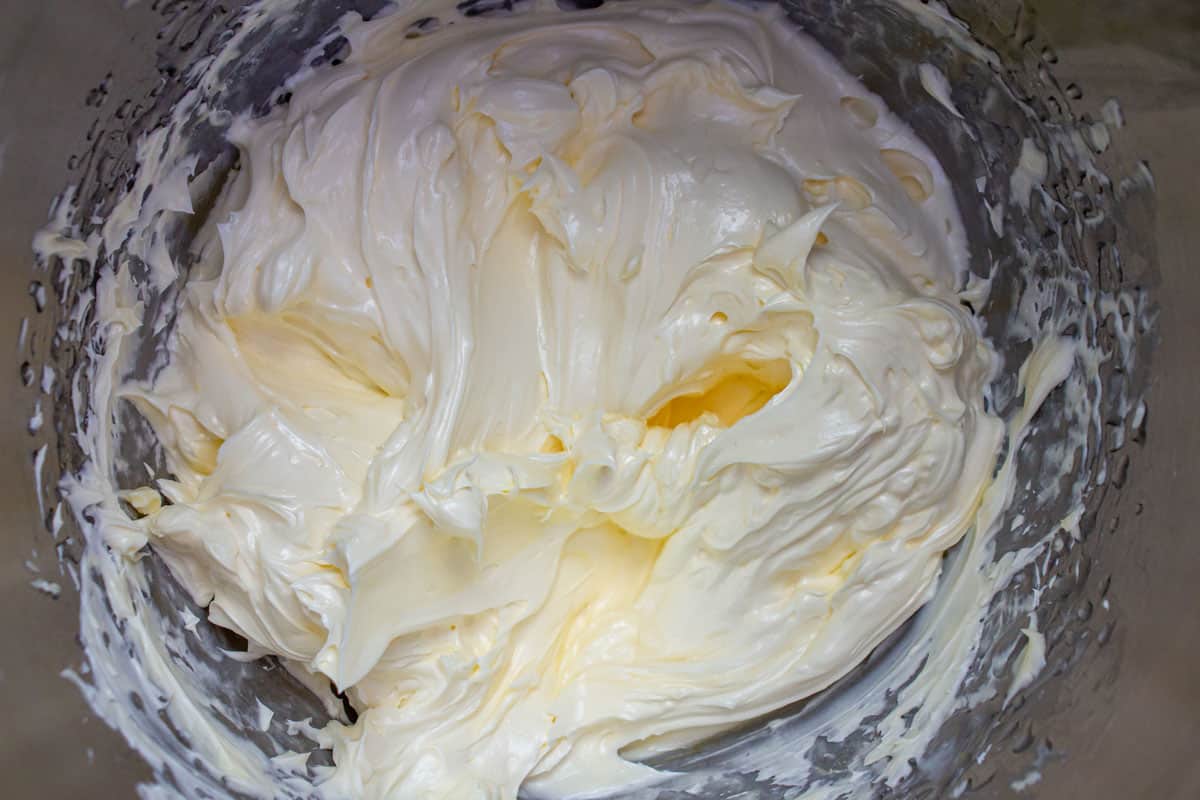
Finally, beat in the kirsch and the red gel food coloring, if using. You'll get more of a coral pink tone rather than a pure pink because the French buttercream has a yellow hue from the egg yolks. Set the buttercream aside at room temperature until you’re ready to assemble.
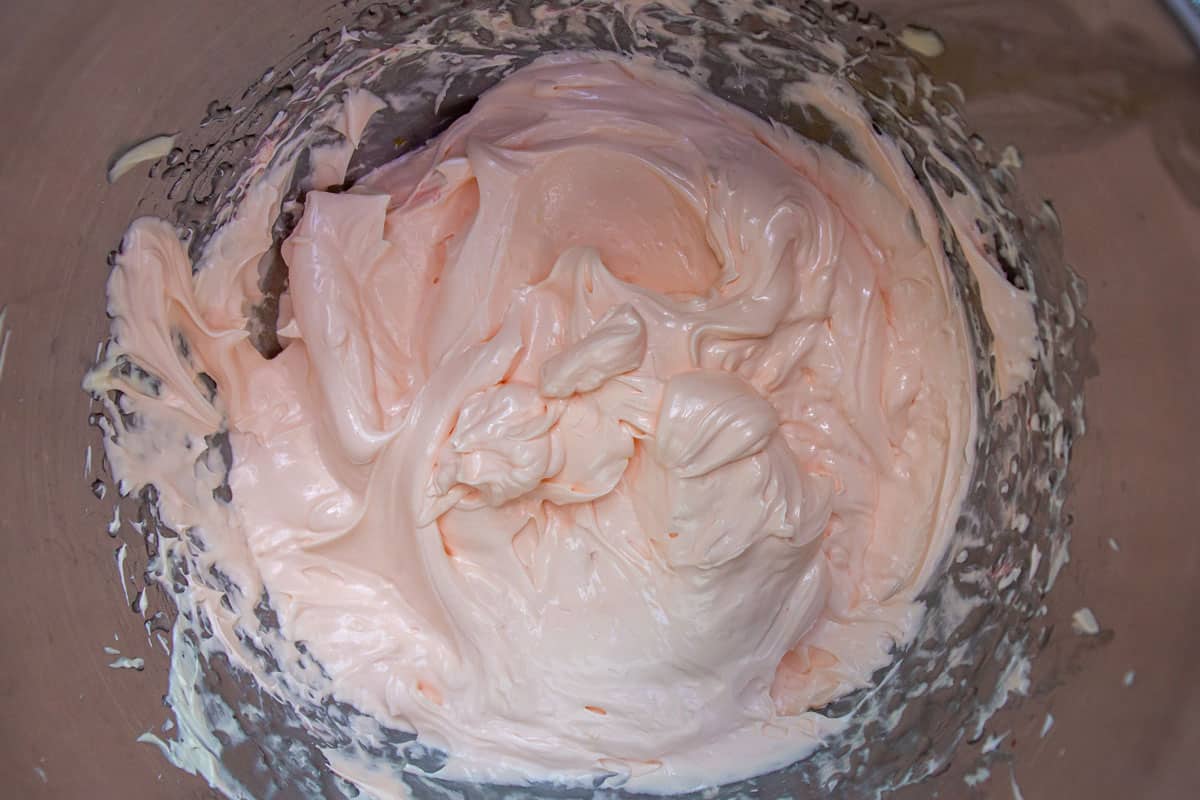
Assembly
Very carefully peel the baked and cooled Japonaise meringues off the parchment paper. Put a few strips of parchment paper around the edges of your serving dish and put a very small amount of the buttercream in the center of the dish. (In the photos below, I just used strips of leftover parchment from baking the Japonaise meringues as to not waste fresh parchment paper). This will hold your cake in place, and the parchment strips will provide clean edges. Alternatively you can assemble your Zuger Kirschtorte on a 9-inch cake board.
Place 1 Japonaise meringue disc on the serving dish or cake board (PHOTO 7). Spread ⅓ of the buttercream evenly over the top (PHOTO 8).

Place the genoise sponge on top (PHOTO 9) and soak it generously with the kirsch syrup (use a pastry brush for even application) (PHOTO 10).
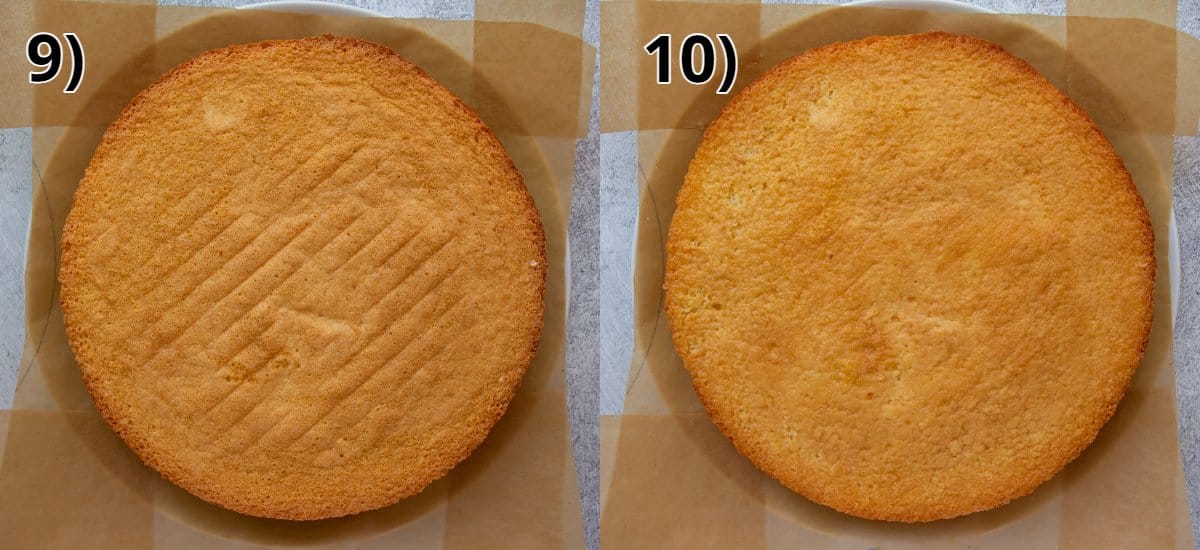
Spread another ⅓ of the buttercream over the genoise layer (PHOTO 11), then top with the remaining Japonaise meringue disc (PHOTO 12).
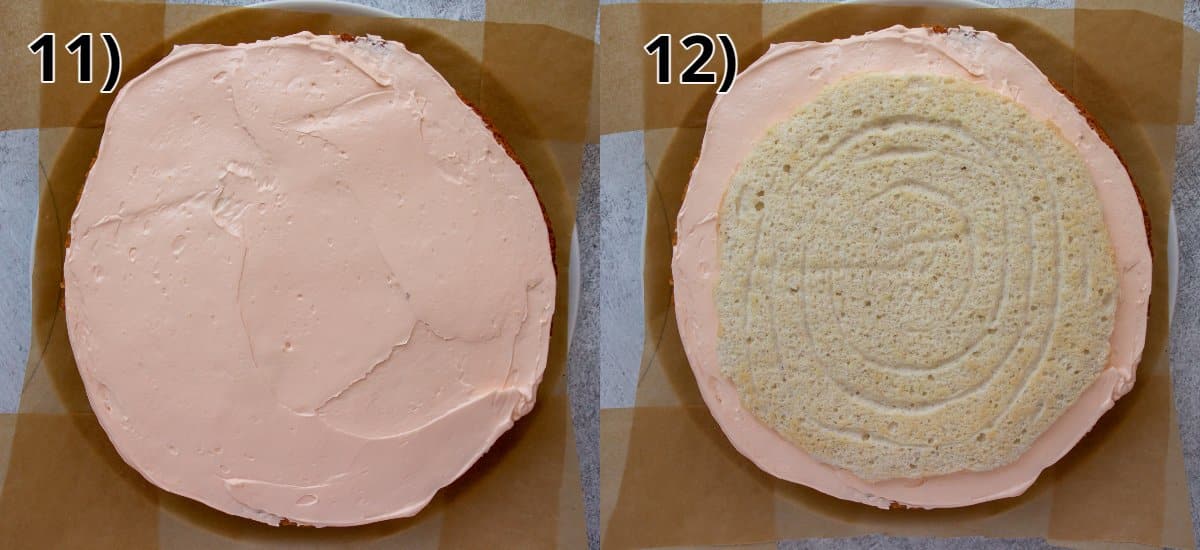
Frost the top and sides of the cake with the remaining ⅓ of the buttercream.
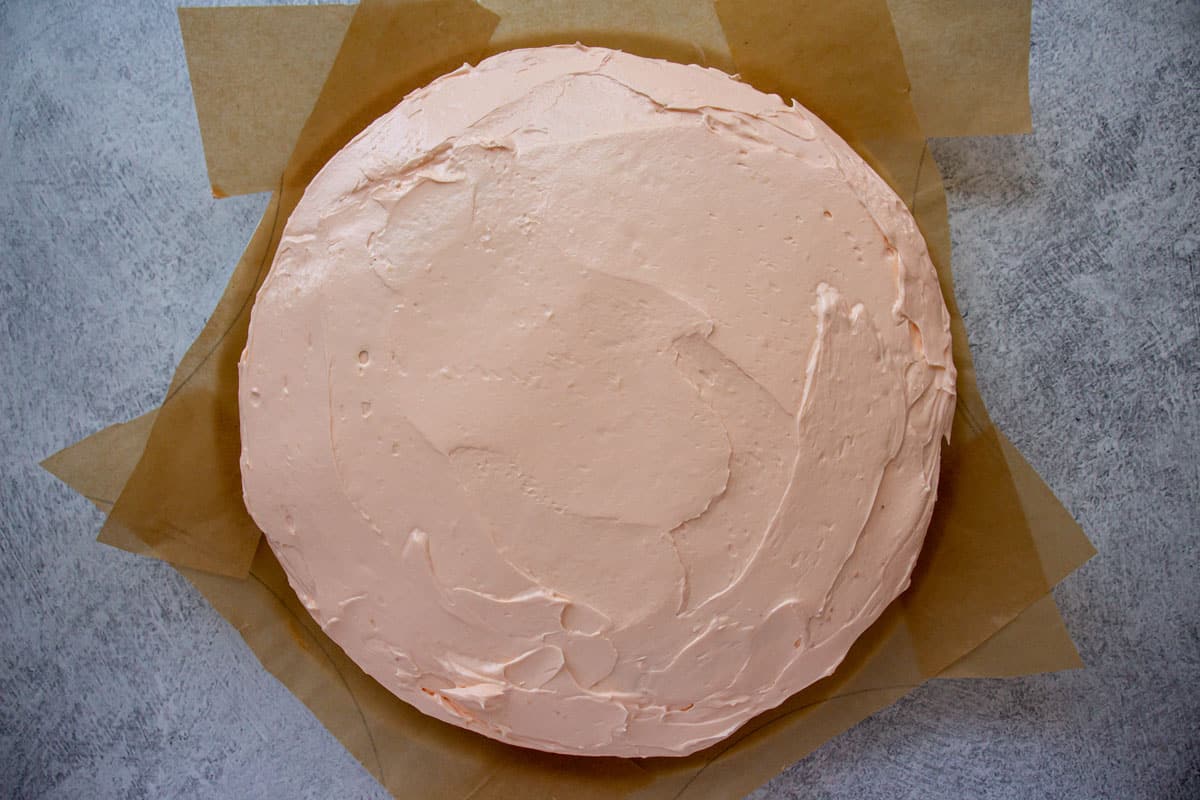
Gently press the sliced toasted almonds around the sides of the frosted torte. Dust the top of the Zuger Kirschtorte with confectioners’ sugar, then score the top into a diamond pattern using the edge of a large offset spatula or the back of a long serrated knife (you want the thickness to be uniform). Remove the parchment paper strips from around the edges and serve.
Please scroll to the bottom of the post for the full recipe (in a printable recipe card) including ingredient amounts and detailed instructions.
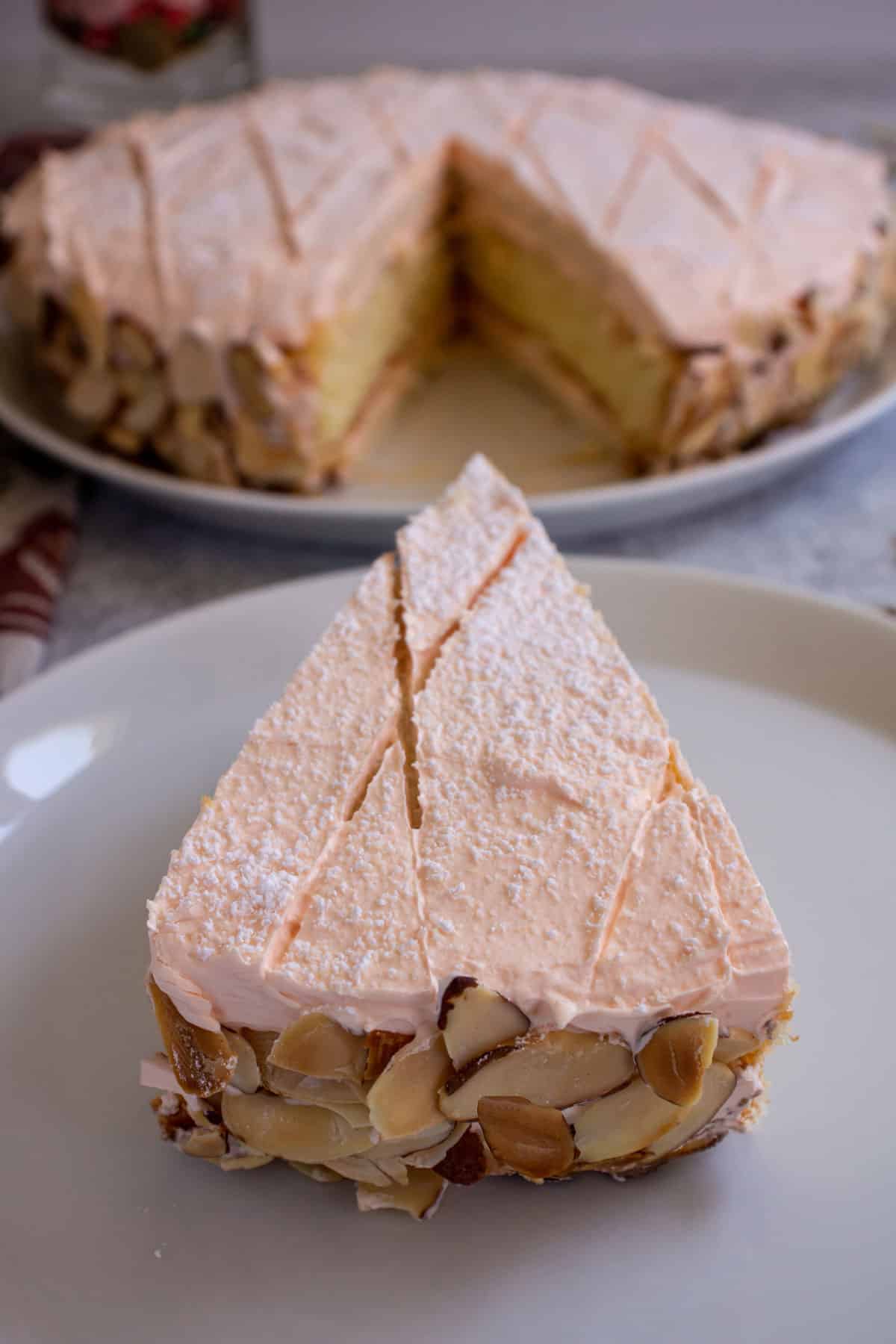
Expert tips and FAQs
You may chill the Zuger Kirschtorte overnight if desired before serving. It will allow time to soak in more of the flavors. Serve the cake at room temperature but continue to store leftovers in the fridge.
Using a digital scale is faster and more accurate than using measuring cups and spoons. I can't stress this enough. Invest in a digital scale if you don't already have one, especially if you like to bake.
You’ll likely need to wash and dry your stand mixer bowl and whisk attachment a few times during the process as they are used for 3 separate components. This adds a few minutes to the prep time for this torte but it’s really negligible since you can do it while components are in the oven, etc.
My Japonaise meringue discs were a little small in diameter. I could have and should have spread them out just a bit more to fill in the circles I drew. They didn't expand as much as I expected, and I had left about 1-inch clearance around the edges. That being said, my Zuger Kirschtorte was still absolutely delicious and the aesthetic difference was hardly noticeable once assembled.

The French terms Dacquoise and Japonaise (sometimes spelled Japonais) are essentially interchangeable and both refer to a nut-based meringue shaped into a disc and used for cake layers. Some people differentiate between the former using hazelnuts and the latter using almonds but it’s not a black and white rule and the terms are often used loosely to describe both.
A genoise sponge cake is leavened naturally with eggs only, using the foaming method which is the gentle warming of the eggs with sugar, and then beating them until they are foamy and thick.
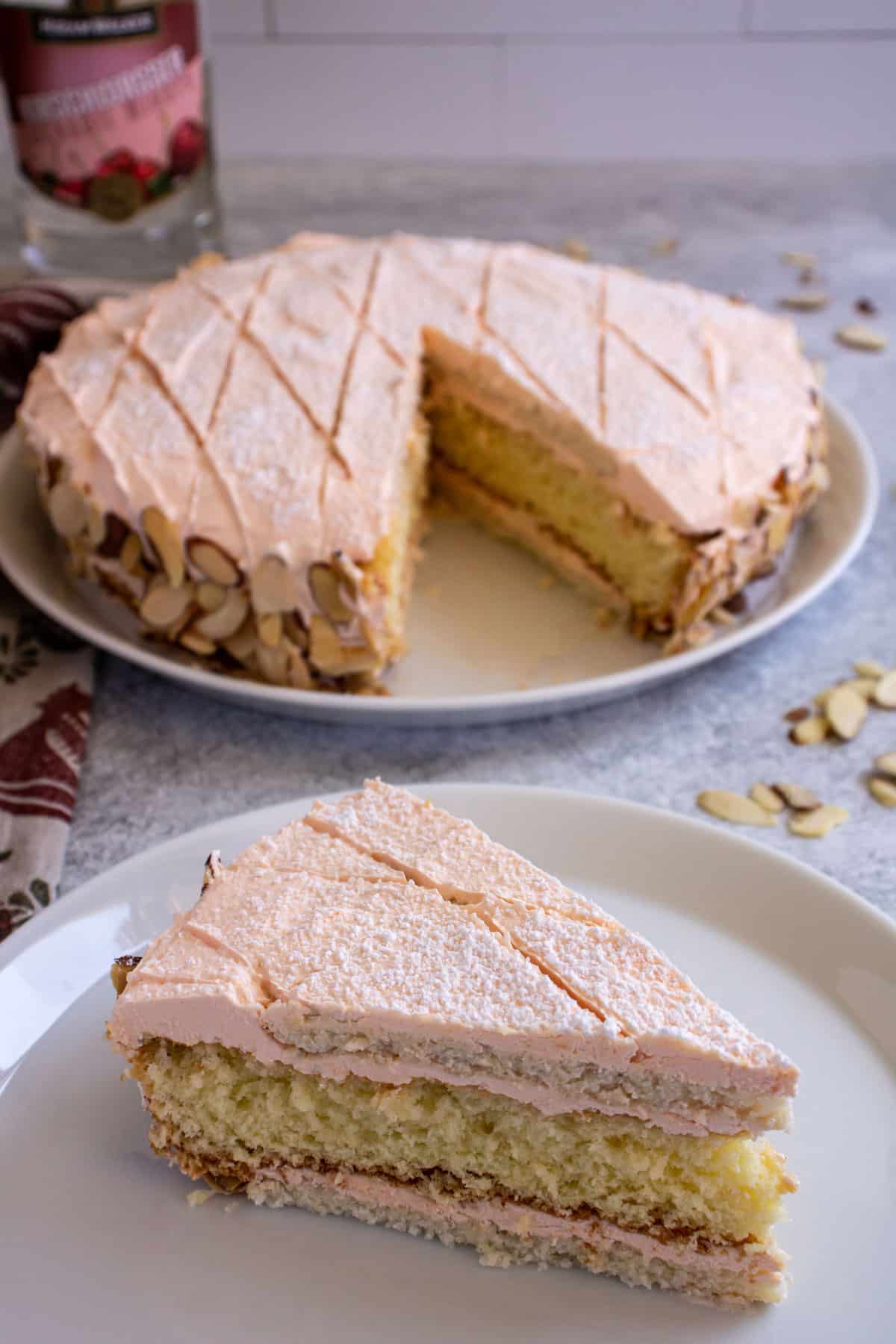
Other recipes you may like
- Aargauer Rüeblitorte (Swiss Carrot Cake)
- Rotweinkuchen (German Red Wine Cake)
- Donauwelle Kuchen (Danube Wave Cake / Snow White Cake)
- Cherry Bakewell Cake
- Wuzetka (W-Z Polish Chocolate Cream Cake)
- Basler Läckerli / Leckerli (Swiss Spiced Cookie Bars)
- Tipsy Cherry Scones (Dried Cherry Scones with Kirschwasser)
- Buchteln (Austrian Stuffed Sweet Rolls)
- Browse all Swiss Recipes
Tried this recipe? Please leave a star ⭐️⭐️⭐️⭐️⭐️ rating in the recipe card below and/or a review in the comments section further down the page. You can also follow me on social media on Facebook, Instagram, and Pinterest!
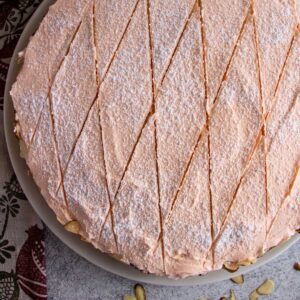
Zuger Kirschtorte (Swiss Cherry Torte from Zug)
Equipment
- Stand Mixer (with Whisk Attachment)
Ingredients
Japonaise Meringue:
- 100 grams (1 cup plus 4 teaspoons) almond meal (almond flour) or finely ground almonds
- 20 grams (2 tablespoons plus 2 teaspoons) cornstarch
- 120 grams (about 4 large) egg whites room temperature
- 75 grams (¾ cup) granulated sugar
Genoise Sponge:
- 3 large eggs
- 100 grams (½ cup) granulated sugar
- 65 grams (½ cup) all-purpose flour
- 25 grams (¼ cup) cornstarch
Kirsch Syrup:
- 3 tablespoons plus 2 teaspoons (55 ml) water
- 25 grams (2 tablespoons) granulated sugar
- 3 tablespoons plus 2 teaspoons (55 ml) kirschwasser (kirsch) liqueur
Kirsch French Buttercream:
- 250 grams (1 ¼ cups) granulated sugar
- ¼ cup (60 ml) water
- 90 grams (about 5 to 6 large) egg yolks
- 225 grams (2 sticks) unsalted butter room temperature
- 2 tablespoons (30 ml) kirschwasser (kirsch) liqueur
- 1 drop red gel food coloring (optional)
Assembly:
- 75 grams (¾ cup) sliced almonds toasted
- Confectioners’ (powdered) sugar
Instructions
Japonaise Meringue:
- Preheat the oven to 350°F (177°C) with the racks in the upper and lower thirds. Draw 9-inch circles on 2 sheets of parchment paper and lay them upside down on 2 baking sheets (you should be able to see the circle drawing through the paper).
- Whisk together the almond meal and cornstarch in a mixing bowl and set aside.
- In the bowl of an electric mixer fitted with the whisk attachment, beat the egg whites at medium speed until you have medium peaks. With the mixer on medium speed, slowly pour in the sugar and continue beating until the mixture is smooth and shiny, and you have stiff peaks. This process will take about 7 minutes from beginning to end.
- Carefully fold in half the almond mixture using a rubber spatula, then fold in the remaining half (doing a little at a time helps mix it evenly without deflating the meringue). Either spread or pipe the mixture in concentric circles (starting in the centers and moving outward) inside the drawn circles, leaving ½-inch clearance from the edges in case it expands.
- Bake meringues for about 10 to 15 minutes, rotating pans partway through, or until they are dry to the touch. Set aside to cool.
Genoise Sponge:
- Preheat the oven to 350°F (177°C) with the rack in the center. Butter a 9-inch round cake pan or 9-inch springform pan and line the bottom with a parchment paper circle cut to fit.
- Fill about an inch of water in a small saucepan and bring it to a boil, then reduce the heat to simmer.
- Combine the eggs and sugar together in the bowl of an electric mixer. Whisk together by hand, then place the bowl over the simmering water (make sure the bowl doesn’t touch the water) and continue whisking by hand until the mixture is about 115°F (46°C), about 5 minutes (the visual cue won’t look too obvious so trust your thermometer and keep whisking).
- Remove the bowl from over the water and place on the mixer stand. Using the whisk attachment on the stand mixer, beat on medium-high speed until it has more than tripled in volume and is pale in color, about 3 to 5 minutes. The outside of the mixer bowl will feel cool to the touch.
- Combine the flour and cornstarch in a small bowl, then sift the mixture over the eggs and gently fold it in using a rubber spatula. Make sure no streaks of flour remain, but do not over-mix.
- Scrape the batter into the prepared pan, smooth the top, and bake for about 22 to 25 minutes, or until the top is golden and springs back when lightly touched in the center. Cool in the pan on a wire rack for 10 minutes, loosen the sides with a spatula if necessary, then unmold the cake from the pan onto a wire rack, peel off the parchment paper and cool completely (if baked in a springform, no need to flip it to peel off the parchment; you can do this after it’s completely cool).
Kirsch Syrup:
- In a small saucepan, combine the water and sugar over medium-high heat. Bring to a simmer, stirring to dissolve the sugar, about 2 to 3 minutes, and then remove from the heat. Cool the syrup completely, then stir in the kirsch. You’ll have about ½ cup. Set aside until ready to use.
Kirsch French Buttercream:
- Make the pâte à bombe base: Combine the sugar and water in a saucepan. Bring to a boil over medium-high heat, gently swirling to dissolve the sugar. Continue to boil the mixture without stirring until it reaches a temperature of 240°F (115°C) using a candy/deep fry thermometer, a total of about 10 minutes.
- Meanwhile, beat the yolks in a stand mixer fitted with the whisk attachment until they are thick and pale.
- Once the syrup reaches 240°F (115°C), immediately remove it from the heat. With the mixer still running (beating the eggs on medium speed), pour the hot syrup very slowly into the beaten yolks (between the whisk and the side of the bowl).
- Continue beating the mixture until it’s completely cool, about 10 to 15 minutes. It will get thick and will be pale creamy white in color.
- Whip in the room temperature butter on low speed a little at a time. Once the butter is fully incorporated, increase the speed to high and beat for another 3 minutes.
- Finally, beat in the kirsch and the red food coloring, if using. Set the buttercream aside at room temperature until you’re ready to assemble.
Assembly:
- Very carefully peel the baked and cooled Japonaise meringues off the parchment paper. Put a few strips of parchment paper around the edges of your serving dish and put a very small amount of the buttercream in the center of the dish. This will hold your cake in place, and the parchment strips will provide clean edges. Alternatively you can assemble your cake on a 9-inch cake board.
- Place 1 Japonaise meringue disc on the serving dish or cake board. Spread ⅓ of the buttercream evenly over the top. Place the genoise sponge on top and soak it generously with the kirsch syrup (use a pastry brush for even application). Spread another ⅓ of the buttercream over the genoise layer, then top with the remaining Japonaise meringue disc flipped upside down so the flat bottom is on top.
- Frost the top and sides of the cake with the remaining ⅓ of the buttercream. Gently press the sliced toasted almonds around the sides of the frosted torte. Dust the top of the torte with confectioners’ sugar (using a small sieve or fine-mesh strainer), then score the top into a diamond pattern using the edge of a large offset spatula or the back of a long serrated knife (you want the thickness to be uniform). Remove the parchment paper strips from around the edges and serve.
Notes
- You may chill the cake overnight if desired before serving. It will allow time to soak in more of the flavors. Serve the cake at room temperature but continue to store leftovers in the fridge.
- Using a digital scale is faster and more accurate than using measuring cups and spoons. I can't stress this enough. Invest in a digital scale if you don't already have one, especially if you like to bake.
- You’ll likely need to wash and dry your stand mixer bowl and whisk attachment a few times during the process as they are used for 3 separate components. This adds a few minutes to the prep time for this cake but it’s really negligible since you can do it while components are in the oven, etc.
- Although the recipe seems long and complicated, it’s surprisingly not. Make sure you read through the before starting, prepare your pans and set out your ingredients ahead of time. A lot of the same ingredients are repeated through the different components.
- You’ll need egg whites for the Japonaise before you need egg yolks for the French buttercream, so I recommend separating the yolks into a bowl, covering with plastic wrap, and refrigerating until you are ready to use them. Then weigh them and add more yolks if needed.
Nutrition
*All nutritional information is based on third-party calculations and should be considered estimates. Actual nutritional content will vary with brands used, measuring methods, portion sizes and more.*

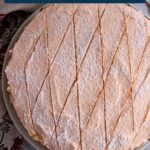
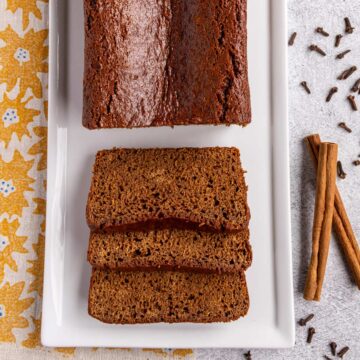


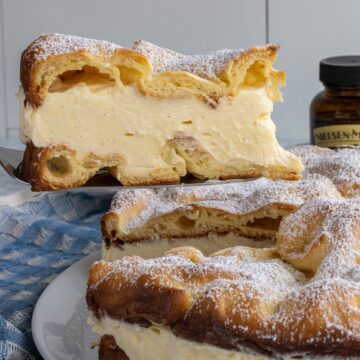
Comments
No Comments